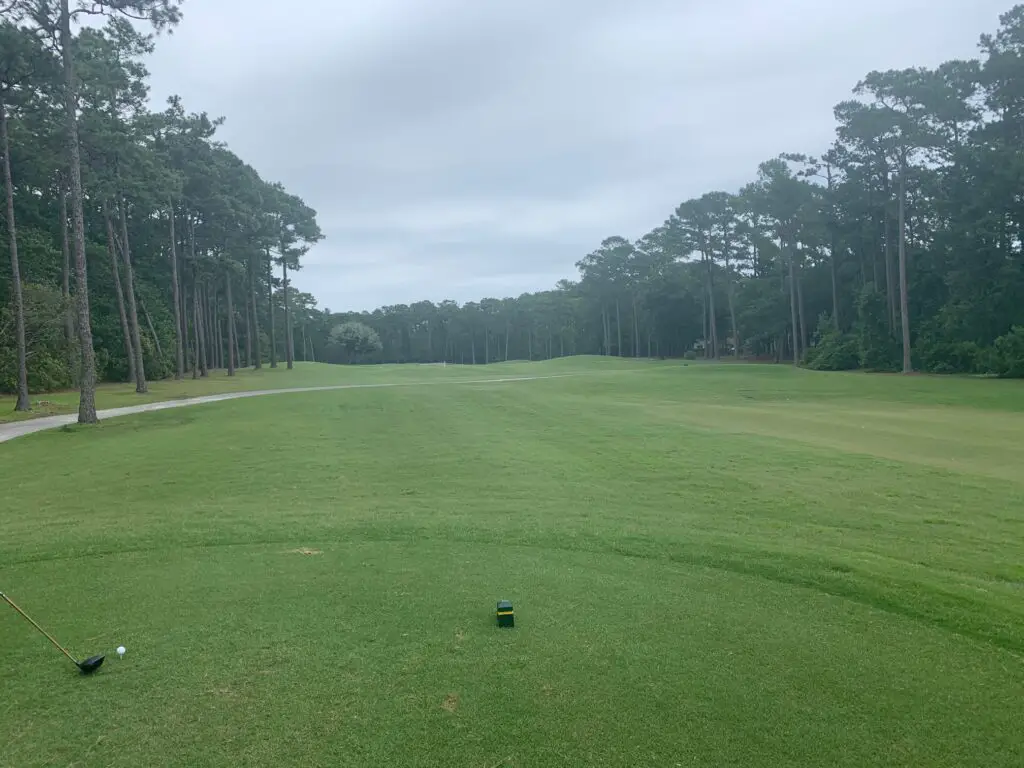There are different types of golf clubs that golfers carry in their bag:
- Drivers
- Fairway Woods
- Hybrids
- Utility Irons
- Irons
- Wedges
- Putters
Most of these clubs, outside of the driver and putter, come in a wide range of lofts and lengths, helping golfers hit the ball various distances.
In the game of golf, rarely do you get a perfect yardage for a club in your bag and you have to make adjustments to try to hit the golf ball a precise distance.
This is why there are different lofted irons and different lengths. For example, a 4 iron is a lower loft and a longer length than the 9 iron.
Which leads us to the main questions for today’s post, which irons should a golfer carry? We provide some insight and advice to help you select the best 14 clubs for your bag.
Which Irons Should I Carry?
At a minimum, a golfer should carry a 7, 8, and 9 iron in addition to several wedges. The higher the swing speed, the more likely to carry additional irons, The lower the swing speed, the more likely to carry more fairway woods and/or hybrids.
Guidelines on the Number of Irons To Carry
There are several categories that we break the driver swing speed down into.
- 105 miles per hour and above
- 95-104 miles per hour
- 94 miles per hour and below
The first step in your journey to figuring out how many irons you should carry is to get a general idea of your swing speed with your driver. There are several ways to accomplish this. The first option is to find a launch monitor and have an official reading. The second option is one of the standby devices that measure just swing speed.
If you need more help, here is a complete post on measuring your driver swing speed.

Category #1: 105 miles per hour and above
If your swing speed with the driver is in this range, chances are you are going to carry the following irons: 4, 5, 6, 7, 8, 9 and several wedges. Some golfers might also add a utility 2 or 3 iron for a total of 7 irons plus the wedges. The golfer would more than likely have a bag that consists of a driver, 3 wood, utility iron, 6 irons, 4 wedges and a putter.
The golfer with the higher swing speed generates enough club head speed to launch the longer iros high enough and far enough to cover the distances from the 3 wood to the lob wedge. The better player with the higher swing speed is looking for control over their golf ball and this often comes with an iron. The more irons for this player the better. They typically have a precise shot chart and know how far they carry each club in their bag.
Why do I hit my irons so short?
Category #2: 95-104 miles per hour
If your swing speed with the driver is in this range, chances are you are going to carry the following irons: 5, 6, 7, 8, 9 and several wedges. From here the golfer has many different options, we would recommend the following: Driver, 3 wood, 5 wood or hybrid, 7 wood or hybrid, 5 irons, 4 wedges and a putter.
This is a total of 14 clubs and gives the golfer great versatility from the 180 yards and above with the hybrids or fairway woods, but plenty of options inside of 110 yards with the wedges. The 5 irons close the 70 yard gap between 180 and 110.
This golfer still possesses some quality swing speed and those on the higher range, that hit their irons solid, might still select to carry a 4 iron! The key is to test out your different options and even own a variety of options that you can adjust based on the course you are playing that takes into account the overall length of the course, the par 3s and the current course conditions.
Single length irons: are they good for my game?
Category #3: 94 miles per hour and below
If your swing speed with the driver is in this range, chances are you are going to carry the following irons: 6, 7, 8, 9 and several wedges. From here the golfer has many different options, we would recommend the following: Driver, 3 wood, 5 wood or hybrid, 7 wood or hybrid, 9 wood or hybrid, 4 irons, 4 wedges and a putter. Of course the golfer should check whether a 4 or 6 wood or hybrid might be a better fit for the golfer.
If the swing speed is below 80 miles per hour with the driver, the golfer might decide to replace the 6 iron with yet another fairway wood or hybrid. Golfers that lack swing speed, often struggle to hit their irons high enough and far enough to reach and hold a green.
They often don’t ask how, just how many. The key is to set the ego aside and put the best 14 clubs in your bag to allow you to hit the highest quality shots.

Next Steps: Measure Your Distances
I would highly recommend each golfer create a distance chart like the sample below:
| Club | Carry Distance (100%) | 90% | 80% |
| Driver | 250 | ||
| 3 Wood | 230 | ||
| 3 Hybrid | 215 | ||
| 2 Utility Iron | 210 | ||
| 4 iron | 190 | ||
| 5 iron | 181 | ||
| 6 iron | 171 | ||
| 7 iron | 163 | ||
| 8 iron | 153 | ||
| 9 iron | 143 | ||
| P Club | 130 | 123 | 115 |
| Pitching Wedge | 118 | 110 | 102 |
| SW Club | 105 | 97 | 91 |
| LW Club | 90 | 82 | 74 |
How can you create your own chart?
Best Option: I would highly recommend a launch monitor!
These portable devices can be used at the driving range, golf course or set up in your home net or golf simulator. These devices are game changers not only on being able to map your bag and know your distances, but they also provide quality feedback after on every shot and provide the following information:
- Carry Distance
- Spin Rate
- Launch Angle
- Spin Axis
- Total Distance
- Ball Speed
This information will help you map your bag, decide on which clubs are best for your game, develop a stock shot and much more. I love using my SkyTrak 365 days a year in my golf simulator setup.
The process for mapping your bag can looking something like this:
- Hit 5 shots with each club in your bag.
- Log the carry distance and total distance for each shot.
- Eliminate any outlier numbers (poor hits or low spin rates).
- Take the average and create a map of your bag.
If you visit any PGA Tour event you will see plenty of golfers utilizing their launch monitors. While most can’t afford a Trackman, there are some very affordable options in the 500-2000 dollar range. I own the SkyTrak and think the world of it.
Here are the top 3 options to check out:

Need More Distance?
I spent many years wondering how I can increase my swing speed. When I was playing junior golf, we weren’t fortunate enough to have some of the training aids and knowledge that is now available. Smart people have studied the golf swing and have created training aids and protocols to help all golfers increase their distance!
At around the same time, the statistics from the PGA Tour have become more clear and the importance of speed is acknowledged by many to be a key to being the best on the PGA Tour.
Steel vs Graphite: Which is better?
Within the past several years, there have been several products hit the market to make speed gains possible. While many people for many years waited for the latest driver to come out to gain an additional 5-10 yards, you can now do this even with your current clubs.
Did you know that with the SuperSpeed Training System you can gain 5-8% increase in swing speed as early as the first training session? This would allow you to gain somewhere between 10 and 30 yards depending on your current swing speed.
SuperSpeed Golf – Use Discount Code Golfjourney365 for some savings!
The SuperSpeed Training System is based on three different swing speed sticks all weighing at different weights. There is a green club that is 10% lighter than the average driver, the blue club which is 5% lighter and the red club which is actually 5% heavier!
Following their prescribed protocols the golfer completes the training every other day. The total time to complete most of their protocols is between 10-15 minutes. Most people can find the time to make this happen. The golfer will also need a swing radar to measure their progress.
The science behind the SuperSpeed Training System is based on overspeed training. Overspeed training has been around for several decades now and has been used by olympic athletics in the sport of Track and Field.
The science behind this overspeed training is based on the premise that your brain will only allow your body to move as fast as it feels it can stop safely! So, you get to work and swing the clubs as fast as possible, retraining your brain to allow you to swing your driver faster.
For more permanent results, the golfer should continue these training protocols for several months. The initial 5-8% is great and can become more permanent with the right length of training. The golfer can expect to continue to break down barriers every several months at a 1-2% increase.
My own experience has been an increase of 7-10 miles per hour on average from between 98-101 all the way up to 106-109. My goal is to hit the PGA Tour average of 113 mph in the coming months. I will continue to train every other day and watch in amazement as I am hitting drivers longer now than ever before!
Phil Mickelson (a senior golfer now) has been known to increase his swing speed in the past year or so and is close to 120 miles per hour in his swing speed. There are potential results for golfers of all ability levels and age!
Check the current price on SuperSpeed Golf System, here!
| Original Swing Speed | After 4-6 Weeks | New Carry Distance | Total Distance |
| 95 | 102 | 245 | 265 |
| 100 | 108 | 259 | 279 |
| 105 | 113 | 271 | 291 |
| 110 | 118 | 283 | 303 |
My Secret To Golf Improvement
Let’s face it, in order to get really good at golf, we must practice frequently. About four years ago, I made the leap and invested in a golf simulator build for my garage. I went with a SkyTrak Launch Monitor and the TGC software and can now play over 100,000 courses including Augusta, Pebble Beach, Bethpage Black, Whistling Straits. St. Andrews and many other of the top 100 courses in the world.
This golf simulator setup, which is more affordable that you might imagine, has been a game changer. I can now play golf everyday of the year regardless of rain, snow, cold weather or time of day. I can practice or play rounds of golf. I can stand in the 11th fairway at Augusta and with the auto-rewind feature I am able to practice my approach shots from various differences.
It is worth checking out through Rain or Shine Golf as they offer some incredible packages along with financing offers that are difficult to beat.
Some direct links to Rain or Shine Golf for pricing and financing:
Take Action – What You Can Do Today to Get Better
What does this mean for you? I believe in the following recipe to get better:
1 – Improve your motion in the golf swing by identifying a golf instructor. Here are some options:
Here is a list of golf instructors that we have reviewed:
2 – Train to swing faster and improve your swing speed. Here are some options:
Looking to gain more Speed and Distance in your swing. Two Options:
3 – Understand course strategy and work to break through your next barrier. Here is a series on breaking through:
We have provided guides on how to break 100, 90, 80 and 70. Check out more below, if interested.
4 – Practice Frequently
Did you know that I build a golf simulator in my garage and have played over 500 rounds of golf on my SkyTrak system? It has been a game changer and one worth checking out. Here are some of my other posts on golf simulators frequently asked questions:
- Is a Golf Simulator Worth It?
- How to Build a Golf Simulator?
- What is the Best Golf Simulator?
- Golf Simulator Accessories?
- How to Build a Golf Simulator for under $7000
- Top 11 Reasons to Buy a SkyTrak
- How to Build a Golf Simulator for Under $1000
- Why Build A Golf Simulator?
- What Space is Needed?
- Can A Golf Simulator Improve My Game?
- How Much Does A Golf Simulator Cost?
- Don’t Forget to Check out our 15 best golf swings of all time.
